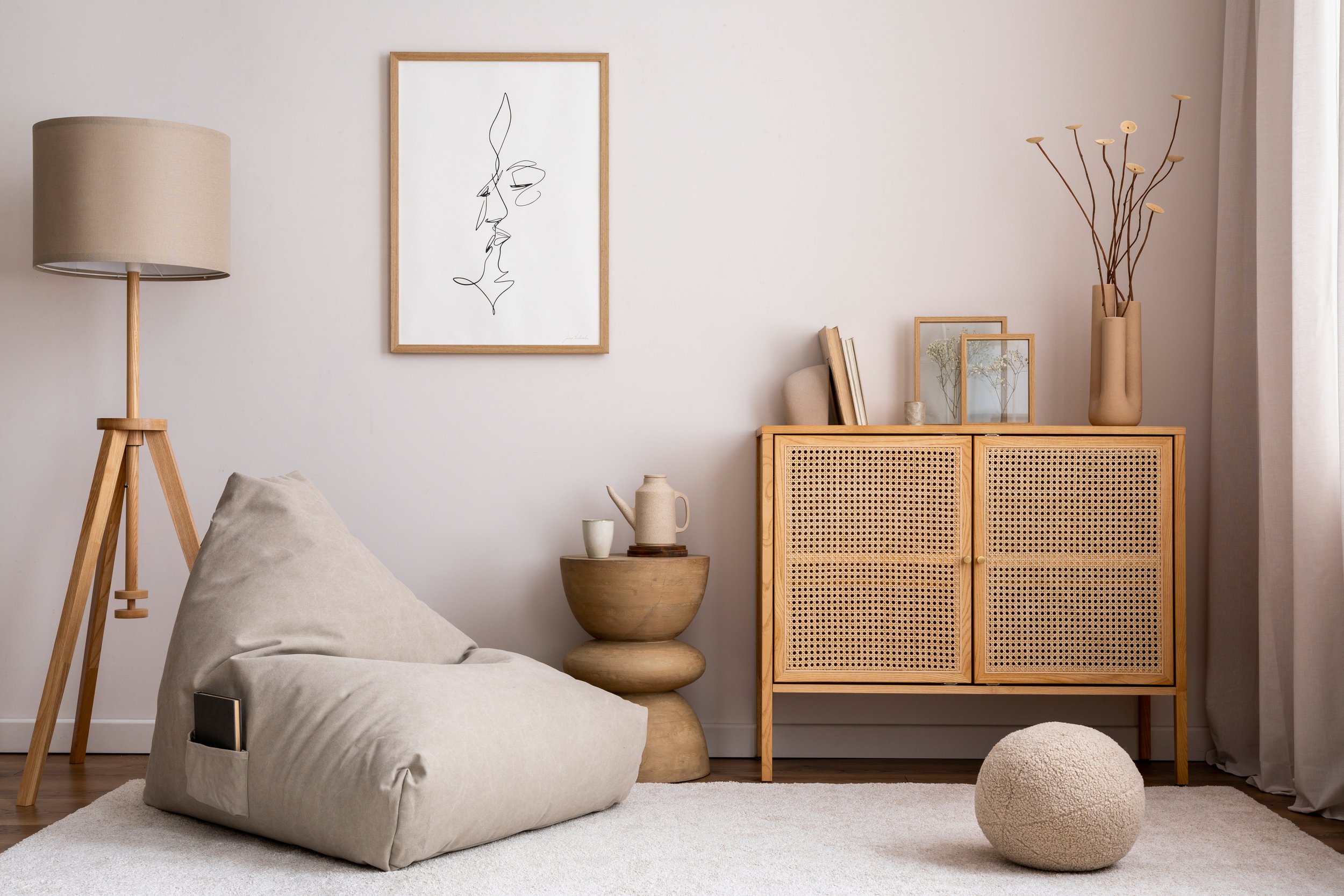Decorating a Small Space to Make it Feel Larger | Lighting
Welcome to the bonus post of the series on design techniques for small spaces. Despite its crucial impact on a room's atmosphere and functionality, lighting design is often an afterthought when it comes to interior styling…. this blog post being a case in point! We'll delve into why lighting is so important and share tips on how to select and place lighting fixtures to create a visually appealing and spacious environment. So, let's shed some light on the topic of lighting and small spaces, shall we?
Photo by FollowTheFlow/Adobe Stock #530773649
5 6 Tips for Decorating a Small Space to Make it Feel Larger
1. Avoid clutter and keep surfaces clean and organized - blog post here
2. Use colour wisely - blog post here
3. Choose furniture that is appropriately scaled for the room - blog post here
4. Incorporate reflective surfaces into your decor - blog post here
5. Use decorative baskets and storage containers - blog post here
6. Bonus post: Decorating a Small Space to Make it Feel Larger | Lighting - post continues below
Decorating a Small Space to Make it Feel Larger | Lighting
If you live in a small space, you know how challenging it can be to create a comfortable, functional environment. However, with the right strategies, you can optimize your space and make it feel larger and more inviting In previous posts, we discussed the benefits of decluttering and creative storage solutions. In this post we will explore another essential aspect of creating a sense of spaciousness in a small room: lighting. Whether you're dealing with a cramped apartment, a tiny bedroom, or a home office, the right lighting can make all the difference in creating a sense of depth and contrast.
Natural Light
One of the most effective ways to create a sense of space in a small room is to maximize natural light. Not only does natural light provide a sense of openness and airiness, but it can also have positive effects on your mood and productivity:
Use sheer window treatments: Heavy curtains or blinds can block natural light and make a room feel smaller. Instead, opt for sheer or translucent window treatments that allow natural light to filter through while providing privacy.
Keep windows clean: Dirt, grime, and streaks on windows can reduce the amount of natural light that enters a room. Be sure to clean your windows regularly to ensure maximum light penetration.
Remove obstructions: Furniture or decor that blocks windows can prevent natural light from entering a room. Consider rearranging your furniture to allow more natural light to flow through the space.
Paint with light colours: Light, neutral paint colours can reflect natural light and create the illusion of space. Consider painting your walls, ceiling, and trim in light colours to optimize natural light in your small room.
Artificial Lighting
While natural light is essential, it's not always enough to create a sense of spaciousness in a small room. That's where artificial lighting comes in. The right combination of task lighting, ambient lighting, and accent lighting can create depth, contrast, and a sense of openness in your small space:
Use multiple light sources: A single overhead light can create harsh shadows and make a room feel small and cramped. Instead, use multiple light sources to create layers of light and depth. Consider using table lamps, floor lamps, and sconces in addition to overhead lighting.
Use dimmer switches: Dimmer switches can create ambiance and allow you to adjust the lighting to fit your mood or activity. By dimming the lights, you can create a cosy, intimate feel in your small room.
Choose the right colour temperature: The colour temperature of your artificial lighting can impact the ambiance of your space. Warm colours (2700-3000K) can create a cozy, inviting feel, while cool colours (5000-6500K) can create a bright, energizing feel. Choose the colour temperature that best fits your desired mood and activity.
Place lighting strategically: The placement of your lighting fixtures can impact the perceived size of your small room. To create a sense of depth and openness, place lighting fixtures at different heights and angles. For example, wall sconces draw the eye upward and pendant lights create vertical interest.
Accent Lighting
In addition to task and ambient lighting, accent lighting can add a sense of depth and contrast to your small room. Accent lighting refers to lighting that draws attention to specific areas or objects in a room, such as artwork, decorative pieces, or architectural features:
Use directional lighting: Directional lighting, such as spotlights or track lighting, can draw attention to specific areas or objects in a room. Use directional lighting to highlight artwork, decorative pieces, or architectural features.
Use candles: Candles can create a cosy, intimate ambiance and add a sense of depth and contrast to your small room. Place candles strategically to draw attention to specific areas or objects in the room.
Use mirrors: Mirrors can reflect light and create the illusion of space in a small room. Place mirrors strategically to reflect natural light or accent lighting and create a sense of depth and contrast.
Lighting Fixtures
The type of lighting fixtures you choose can impact the ambiance of your small room:
Choose fixtures that fit the scale of your room: In a small room, oversized lighting fixtures can overwhelm the space and make it feel cramped. Choose fixtures that fit the scale of your room and provide the appropriate amount of light.
Choose fixtures with open or translucent shades: Fixtures with open or translucent shades allow light to pass through, creating a sense of openness and space. Avoid fixtures with opaque shades that block light and make your small room feel smaller.
Choose fixtures with reflective surfaces: Fixtures with reflective surfaces, such as polished metal or glass, can reflect light and create a sense of depth and openness in your small room.
Choose fixtures with adjustable arms or shades: Fixtures with adjustable arms or shades allow you to direct light where you need it most. This can be especially useful in a small room where you may need to adjust lighting to fit your mood or activity.
Lighting is a crucial element in creating a sense of spaciousness and comfort in small spaces. By selecting the right type of lighting, using accent lighting to draw attention to focal points, and strategically placing fixtures, you can transform a cramped room into a cosy and inviting oasis. Remember to consider the colour temperature and rendering properties of your lighting, and don't be afraid to experiment with different types of fixtures to achieve the desired effect. With these tips in mind, you will be able to use lighting to make the most of your small space and create a functional, visually appealing environment.


